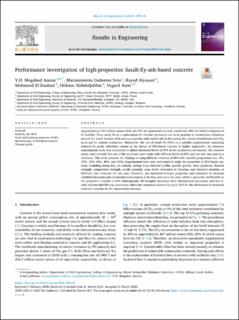| dc.description.abstract | Approximately 544 million tonnes of fly ash (FA) are generated annually worldwide, 80% of which is disposed of in landfills. Thus, using FA as a replacement for cement has turned out to be popular in construction industries around the world because of its strong properties and crucial role in decreasing the volume of pollutants and CO2 produced by cement production. Meanwhile, the use of Saudi FA (SFA) as a suitable supplemental cementing material to partly substitute cement in the design of SFA-based concrete is highly imperative. An extensive experimental study was conducted to utilize increased levels of SFA in the production of concrete. Six concrete mixes were utilized: five out of the six mixes were made with different levels of SFA and one mix was used as a reference. This study presents the findings of using different volumes of SFA with variable proportions (i.e., 0%, 10%, 20%, 30%, 40%, and 50%). Experimental tests were performed to study the properties of SFA-based concrete, including slump test, air content, setting times, thermal profile, specific gravity, sieve gradation, flexural strength, compressive strength, tensile strength, wear depth, resistance to abrasion, and elasticity modulus, at different time intervals for one year. However, the hardened strength properties and resistance to abrasion exhibited incessant and substantial enhancement at 56 days and up to one year, which is generally attributable to the pozzolanic reaction of SFA. Subsequently, all strengths increased when thermal heat decreased, and test results indicate that SFA can potentially substitute cement in concrete by up to 50% for the fabrication of structural concrete elements in the construction industry. | en_US |

